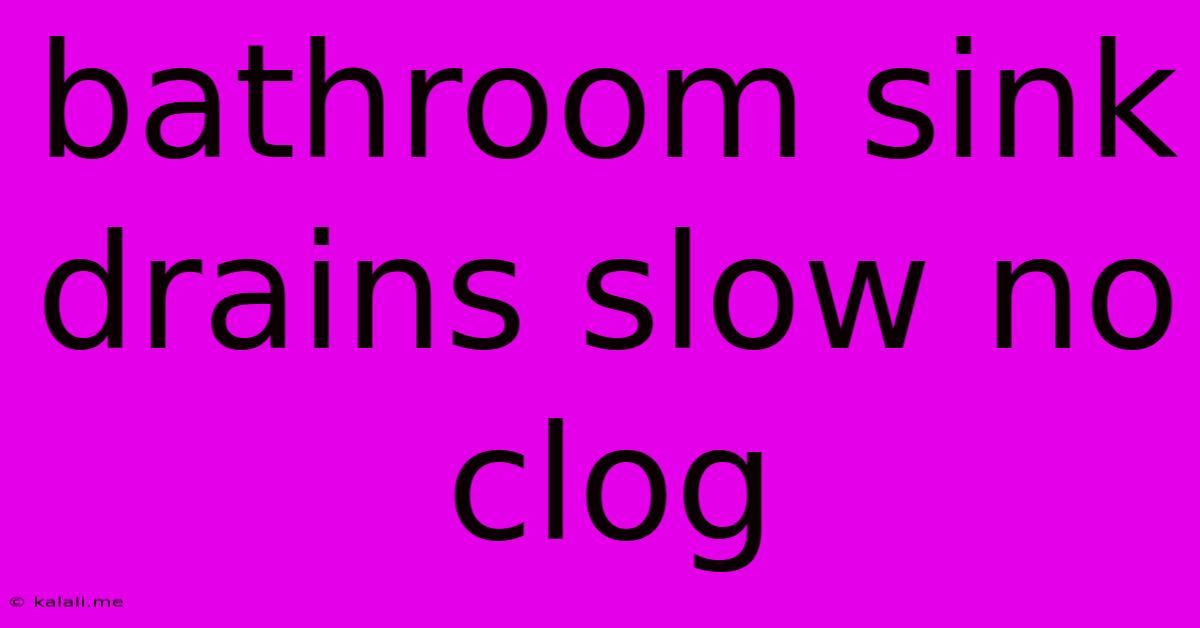Bathroom Sink Drains Slow No Clog
Kalali
Jun 04, 2025 · 3 min read

Table of Contents
Bathroom Sink Drains Slow: Troubleshooting Without a Clog
A slow-draining bathroom sink is frustrating, especially when you're sure there's no clog. The problem isn't always a blockage; sometimes, it's a buildup of grime, soap scum, hair, or mineral deposits restricting water flow. This article explores common causes and solutions for a slow-draining bathroom sink without a visible clog, helping you restore efficient drainage without resorting to harsh chemicals.
Why is my bathroom sink draining slowly? Slow drainage isn't always caused by a major blockage. Often, it's a gradual accumulation of smaller issues that combine to restrict water flow. This can include mineral buildup, soap scum, and even the natural aging of your pipes. This guide helps you troubleshoot these issues effectively.
1. Mineral Deposits and Soap Scum Buildup
Over time, hard water minerals and soap scum can accumulate inside your pipes and drain, creating a film that restricts water flow. This is especially common in areas with hard water. The buildup can narrow the diameter of your pipes, significantly slowing drainage.
- Solution: Boiling water is your first line of defense. Pour a kettle of boiling water down the drain. The heat can help melt away some of the soap scum and loosen mineral deposits. Repeat this process several times for better results. You can also try a mixture of baking soda and vinegar. Combine 1 cup of baking soda with 1 cup of vinegar, pour it down the drain, and let it fizz for about 30 minutes before flushing with hot water.
2. P-Trap Issues
The P-trap, that curved pipe under your sink, is designed to trap debris and prevent sewer gases from entering your bathroom. However, sometimes it can become partially clogged with hair, soap scum, or other small particles.
- Solution: Carefully disconnect the P-trap (place a bucket underneath to catch water) and inspect it thoroughly. Clean out any visible debris using a wire hanger or plumber's snake. Reassemble the P-trap, ensuring a tight seal to prevent leaks.
3. Vent Stack Problems
The vent stack is a crucial part of your plumbing system. It allows air to enter the drainage system, preventing suction that can slow or stop drainage. A clogged or damaged vent stack can affect multiple drains in your home.
- Solution: This is a more complex issue requiring professional plumbing intervention. If you suspect a vent stack problem, it's best to contact a qualified plumber. They have the tools and expertise to diagnose and repair vent stack issues.
4. Pipe Degradation
Over time, pipes can corrode or become damaged, reducing their internal diameter and affecting drainage. This is more common in older homes with metal pipes.
- Solution: Pipe replacement is often necessary for significant degradation. This requires professional help. Inspecting your pipes visually, if accessible, might reveal signs of corrosion.
5. Improper Installation
Rarely, a slow drain can be caused by improper installation of the plumbing fixtures. This might involve issues with pipe angles or insufficient slope, leading to poor drainage.
- Solution: This requires a plumbing professional to investigate and make necessary adjustments.
Prevention is Key: Maintaining a Smooth-Flowing Sink
Regular maintenance is vital to preventing slow drains. Consider these preventative measures:
- Regular Cleaning: Pour boiling water down the drain weekly to help prevent soap scum buildup.
- Hair Prevention: Use a drain strainer to catch hair and other debris.
- Avoid Pouring Grease Down the Drain: Grease solidifies in pipes, causing clogs.
- Chemical Drain Cleaners (Use Sparingly): Use chemical drain cleaners only as a last resort, and always follow the manufacturer's instructions carefully. They can damage pipes over time.
By following these troubleshooting steps and implementing preventative measures, you can likely resolve a slow-draining bathroom sink without a clog and keep your plumbing system running smoothly. If you've tried these solutions and the problem persists, it's advisable to call a qualified plumber for a professional assessment.
Latest Posts
Latest Posts
-
How To Get Cigarette Smell Out Of Apartment
Jun 06, 2025
-
Lutheran Vs Campus Crusade For Christ Beliefs Difference
Jun 06, 2025
-
Gas Pump Pre Pay Time Out Refund
Jun 06, 2025
-
Well Water Pressure Drops Then Comes Back
Jun 06, 2025
-
What Should My Car Battery Voltage Be
Jun 06, 2025
Related Post
Thank you for visiting our website which covers about Bathroom Sink Drains Slow No Clog . We hope the information provided has been useful to you. Feel free to contact us if you have any questions or need further assistance. See you next time and don't miss to bookmark.